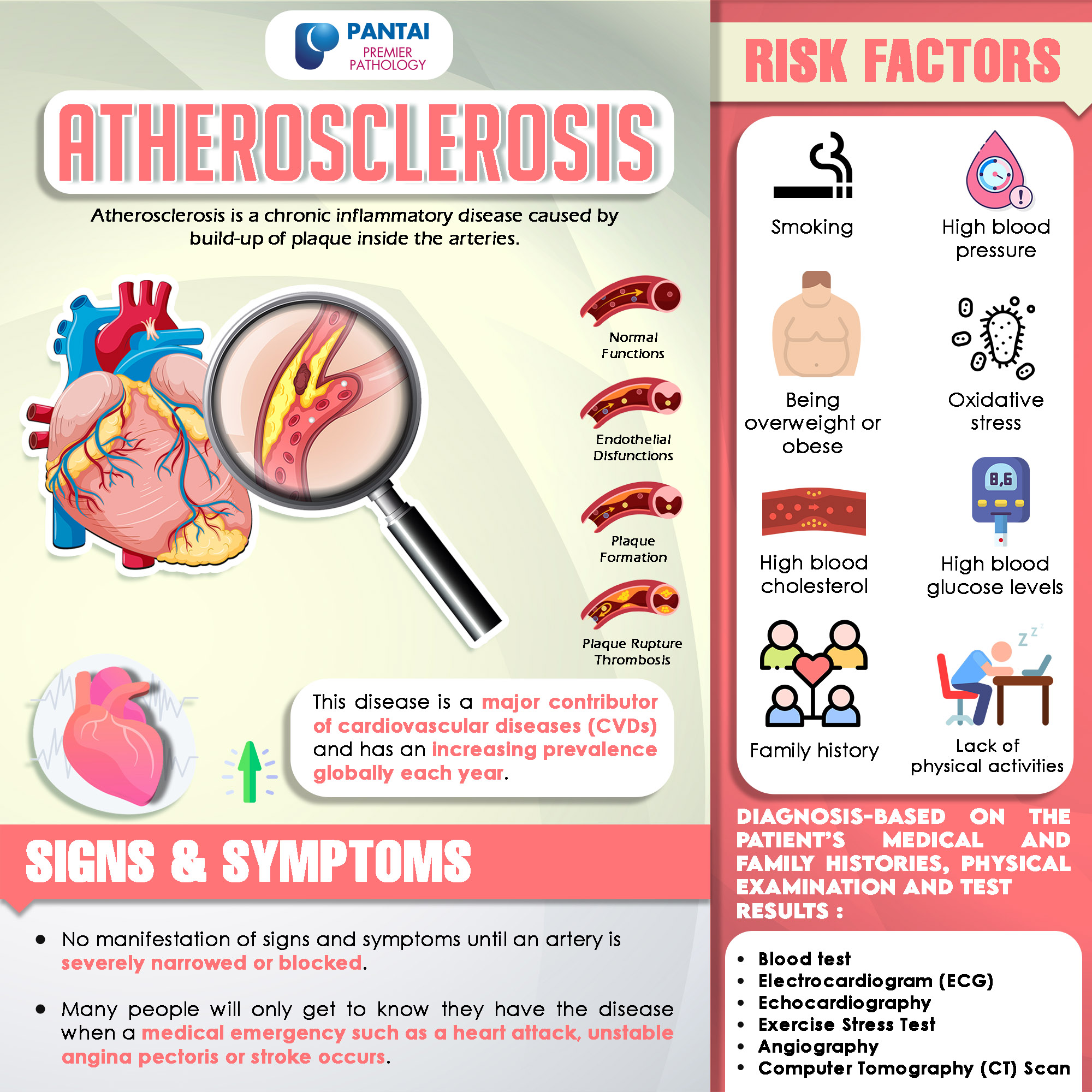What is Atherosclerosis and how it can contribute to heart disease?
Atherosclerosis is a chronic inflammatory disease caused by build-up of plaque inside the arteries.1, 2, 3 This disease is a major contributor of cardiovascular diseases (CVDs) and has an increasing prevalence globally each year.2, 3, 4
The chronic build-up of plaque (fatty deposits) in the artery wall causes blood vessel thickening and arterial stenosis (narrowing of artery wall). The narrowing within the artery channel will result in blood flow restriction, thereby, leading to tissue hypoxia.5, 6, 7, 8
Immune activation was identified in the atherosclerotic plaque where inflammatory cells are attracted within the arterial wall and into the atherosclerotic plaque, hence, promoting the progression of atherosclerotic lesions.2, 6, 7, 8
Signs & Symptoms
Atherosclerosis usually does not manifest any signs and symptoms until an artery is severely narrowed or blocked. Many people will only get to know they have the disease when a medical emergency such as a heart attack, unstable angina pectoris or stroke occurs.9, 10
Some individuals may have signs and symptoms of the disease which depends on which arteries are affected.11
Risk Factors
Atherosclerosis is a slow and complex disease which may develop in childhood and progress as a person ages.5, 11
Some common factors that cause damage to the inner lining of the arteries which will lead to atherosclerosis to take place are smoking, high blood pressure, being overweight or obese, oxidative stress (reactive oxygen species), high blood cholesterol, high blood glucose levels, family history and lack of physical activities.5, 11, 12, 13
Diagnosis
A medical practitioner will diagnose atherosclerosis based on the patient’s medical and family histories, physical examination and test results.5, 14
Blood Tests
A blood test is done to measure the levels of certain fats, cholesterol, glucose and proteins (biomarkers) in the blood. Abnormal levels of these parameters may be a sign that a person is at an increased risk of developing atherosclerosis.5, 14
Electrocardiogram (ECG)
An ECG is a simple and painless test that detects and records the electrical activity of the heart. The test can detect signs of a previous or current heart attack.5, 14
Echocardiography
An echocardiography test shows the size and shape of the heart and how well the heart chambers and valves are functioning. The test can also identify poor blood flow areas of the heart, areas of heart muscles that are not contracting normally and previous injury to heart muscle due to poor blood flow.5, 14
Exercise Stress Testing
During a stress test, the patient is required to exercise and make the heart work hard and beat fast while the heart tests are performed. Arteries that are narrowed due to plaque build up do not supply adequate amounts of oxygen-rich blood to the heart, hence, a stress test indicates possible symptoms of a coronary artery disease.5, 14
Angiography
An angiography test is done to observe the inside of the arteries by using dye and special x-rays. This test can show whether the arteries are blocked by a plaque and how severe is the blockage.5, 14
Computer Tomography (CT) Scan
A CT scan can show if an artery is hardening or narrowing. The test can also indicate when there is calcium build up in the walls of the coronary arteries which is an early sign of a coronary artery disease.5
————————————————————————————————————————
Screening for asymptomatic atherosclerosis is important for an early diagnosis as an efficient strategy to control risk factors and prevent or delay atherosclerosis and its related diseases. It is also crucial to identify patients that require long-term surveillance, medication or surgery.5, 15, 16
At Pantai Premier Pathology, we provide screening tests for Heart Disease. For more information on the tests provided, please contact us at +603-42809115 (Customer Service) or email us at info@premierpathology.com.my.
———————————————————————————————————————–
References:
- Wolf, D., & Ley, K. (2019). Immunity and inflammation in atherosclerosis. Circulation research, 124(2), 315-327.
- Gregersen, I., & Halvorsen, B. (2018). Inflammatory Mechanisms in Atherosclerosis [E-book]. In Atherosclerosis. Licensee IntechOpen. https://doi.org/10.5772/intechopen.72222
- Taleb, S. (2016). Inflammation in atherosclerosis. Archives of cardiovascular diseases, 109(12), 708-715.
- Cardiovascular Diseases (CVDs). (2017, May 17). World Health Organization. https://www.who.int/en/news-room/fact-sheets/detail/cardiovascular-diseases-(cvds)
- Atherosclerosis. (2017, April 30). American Heart Association. https://www.heart.org/en/health-topics/cholesterol/about-cholesterol/atherosclerosis
- Wolf, D., & Ley, K. (2019). Immunity and inflammation in atherosclerosis. Circulation research, 124(2), 315-327.
- Libby, P., Ridker, P. M., & Maseri, A. (2002). Inflammation and atherosclerosis. Circulation, 105(9), 1135-1143.
- Tuttolomondo, A., Di Raimondo, D., Pecoraro, R., Arnao, V., Pinto, A., & Licata, G. (2012). Atherosclerosis as an inflammatory disease. Current pharmaceutical design, 18(28), 4266-4288.
- Boamponsem, A. G., & Boamponsem, L. K. (2011). The role of inflammation in atherosclerosis. AASRFC. ISSN, 978610, 194-207.
- McCurdy, L. E., Winterbottom, K. E., Mehta, S. S., & Roberts, J. R. (2010). Using nature and outdoor activity to improve children’s health. Current problems in pediatric and adolescent health care, 40(5), 102-117.
- Atherosclerosis. (n.d.). National Heart, Lung and Blood Institute. Retrieved August 26, 2020, from https://www.nhlbi.nih.gov/health-topics/atherosclerosis
- Wang, L., Ai, D., & Zhang, N. (2017). Exercise Benefits Coronary Heart Disease. Advances in experimental medicine and biology, 1000, 3–7. https://doi.org/10.1007/978-981-10-4304-8_1
- Crowther, M. A. (2005). Pathogenesis of atherosclerosis. ASH Education Program Book, 2005(1), 436-441.
- Seong, A. C., & John, C. K. M. (2016). A review of coronary artery disease research in Malaysia. Med J Malaysia, 71(Supplement 1), 46.
- Woo, S. Y., Joh, J. H., Han, S. A., & Park, H. C. (2017). Prevalence and risk factors for atherosclerotic carotid stenosis and plaque: A population-based screening study. Medicine, 96(4), e5999. https://doi.org/10.1097/MD.0000000000005999
- Macedo, L. E. T. D. (2017). Cholesterol and prevention of atherosclerotic events: limits of a new frontier. Revista de saude publica, 51, 2.



